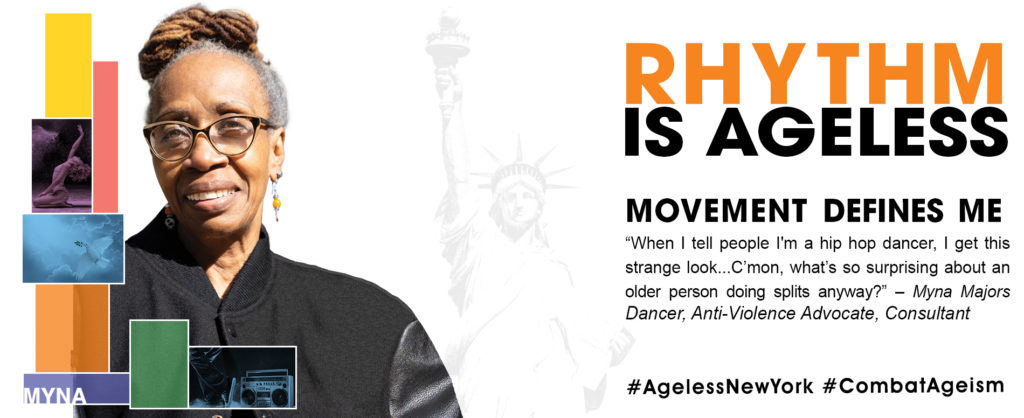
Like sexism and racism, ageism is another form of prejudice and discrimination that is insidious in our culture. Ageism affects us all – after all, we are aging the minute we are born. Paying attention and recognizing that it is all around us – in the media, in the workplace and within ourselves – is the first step in combatting it.
Tips
A powerful first step to stamp out ageism is to acknowledge how our own biases impact our interactions with older adults. Everybody has some strengths and good qualities. Highlight those and try to avoid the negatives you perceive.
Creating awareness requires understanding that there is a problem. Learn to become more aware of how older adults are portrayed in movies, TV shows and commercials. Call out ageism in the workplace and support your older colleagues.
Call out language that promotes negative stereotypes. The use of terms such as “back in your day” or “you are just old-fashioned” is inappropriate. Ask yourself, would I like it if someone called me “honey” or “sweetie,” or talked to me extremely loudly or slowly? This is called elder speak, which older adults find patronizing and demeaning. Speak with older adults as equals and respectfully.
Connect with older adults. It breaks down barriers and stereotypes. Try volunteering in your community or reach out to older neighbors, relatives and friends.
The New York City Department for the Aging launched Ageless New York to bring awareness to the last socially accepted form of discrimination. From colloquialism to media, ageism needs to be stamped out from its roots. Steady public awareness and education is the first step in this endeavor.
Get Involved
There are many ways, large and small, to get involved in making a difference, such as launching awareness campaigns to increase knowledge about and understanding of ageism present in the media, general-public, policymakers, employers and service providers.
If you are older and still working, be your own advocate. Age discrimination is alive and well in the workplace despite 50 years of laws intended to protect older Americans’ right to work. AARP offers adults 50 and older resources such as job training programs and resume-building to help them find work. They work with employers to create an age-inclusive workplace and counsel them on how to establish diversity and inclusion task forces, age-bias training programs and diversifying sources of job candidates. It also lobbies for legislation to fight ageism in the workplace.
On a broader level, city, state and federal legislators fight for stricter anti-discrimination laws. Know who your representatives are and who is supporting laws that fight ageism. In July 2020, the New York City Commission on Human Rights released legal enforcement guidance on employment discrimination on the basis of age, providing recommendations on how to attract and sustain an intergenerational workforce.
Every day, we have an opportunity to become an aging advocate.
Q & A
What is ageism?
Ageism is the stereotyping and discrimination against individuals or groups based on their age. Ageism can take many forms, including prejudicial attitudes, discriminatory practices, or institutional policies and practices that perpetuate stereotypical beliefs.
Should we be concerned about ageism?
Yes. Research has shown that ageism negatively impacts the health and wellbeing of older adults and can lead to cardiovascular problems, reduced self-efficacy, increases in social isolation, physical and cognitive decline, and lack of physical activity.
Ageist stereotypes in the media can also affect future generations. According to a report by the Royal Society for Public Health, children as young as six begin to develop stereotypes about older people – which is often reinforced throughout their lives. Children’s television shows and movies often typecast older characters as wise or crazy, rarely as the main character and usually in an unflattering light.
At what age do people experience ageism?
An AARP study of workers between the ages of 45 and 74 found that most people believe age discrimination begins when workers hit their 50s. Still, 22 percent believe it begins even earlier, when workers hit their 30s and 40s, and 17 percent say they think it begins in one’s 60s.
Am I Ageist?
Only we know the answer. Each of us must learn to become aware of our own thoughts and ask ourselves this question when interacting with older adults. A good step is to acknowledge how your own biases impact your interactions with older adults. Call out language that promotes negative stereotypes, and connect with older adults. It breaks down barriers and stereotypes.
Is Ageism illegal?
It is illegal to discriminate against an individual on the basis of their age. For example, age discrimination is illegal at any stage of employment, including during hiring, promotions, raises and layoffs. In addition, it is illegal to discriminate against individuals on the basis of their age when it comes to housing, too.
How do I handle signs of ageism in the workplace?
You may be a victim of ageism if you are being overlooked or passed over for challenging assignments, being left out of client meetings or company activities, or if learning opportunities are automatically offered to younger employees — not older ones. Read here for some tips on to how to handle them.
What can I do to combat ageism?
There are many things you can do to limit ageism in your community. Undertake outreach campaigns to increase knowledge about and understanding of aging among the media, general-public, policymakers, employers and service providers. Call out language that promotes negative stereotypes. Connect with older adults and volunteer in your community. Support legislators and elected officials who back laws that fight ageism.